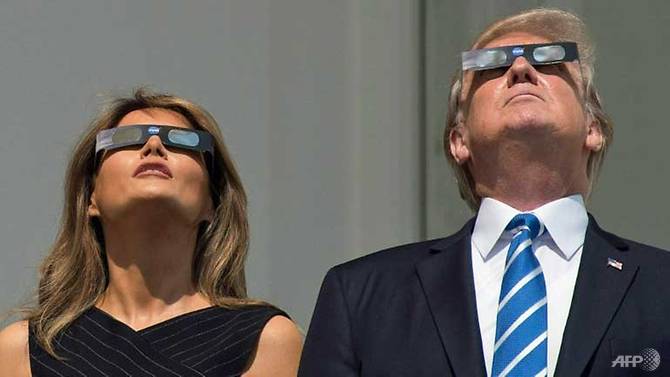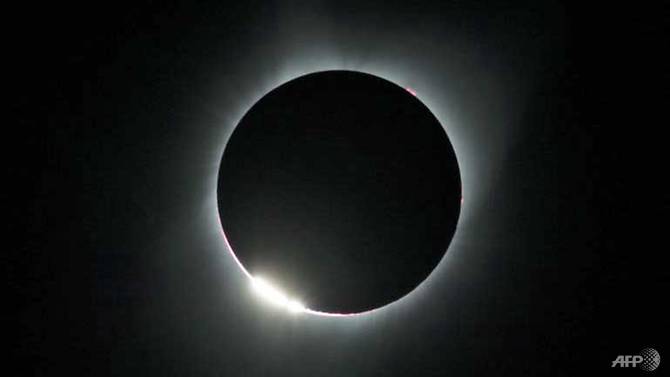Total solar eclipse completes path across America
 |
| US President Donald Trump and First Lady Melania Trump look up at the partial solar eclipse from the balcony of the White House in Washington, DC. (NICHOLAS KAMM/AFP) |
Millions of eclipse chasers and amateur star watchers alike converged in cities along the path of totality, a 113-kilometre wide swath cutting through 14 US states, where the moon briefly blocked out all light from the sun.
"It was incredibly beautiful. I am moved to tears," said Heather Riser, a 54-year-old librarian from Virginia, sitting on a blanket in Charleston's grassy Waterfront Park where thousands had gathered to watch.
 |
Festivals, rooftop parties, weddings, camping trips and astronomy meet-ups popped up nationwide for what NASA expected to be the most heavily photographed and documented eclipse in modern times, thanks to the era of social media.
The blackest part of the eclipse, known as totality because the moon blocks all the sun's light from the Earth, began over Lincoln Beach, Oregon at 5.16pm GMT (1.16am, Tuesday, Singapore time).
Crowds whooped and cheered at the first sign of darkness.
Just inland, more than 100,000 people gathered at Madras, Oregon - typically a town of 7,000 - in what experts described as perfect viewing conditions.
"You're just blown away, this feeling inside you is really the definition of 'awe' and 'awesome,'" said Rich Krueger, a science professor.
"Seeing the corona extend out, feeling the coolness, hearing the crowd, just being a part of it with all these people, and especially my students and co-workers is just amazing."
In Los Angeles, "oohs and aahs" emanated from the crowd of thousands gathered at the Griffith Observatory in the hills above the city as the partial eclipse began.
Many had hiked to the site to avoid massive traffic jams. Some watchers had fashioned their own pinhole projectors out of cardboard and scotch tape. Others watched while wearing special, dark solar eclipse glasses.
"This is a once in a lifetime event," said 42-year-old Chad Briggs.
"JUST AWESOME"
In downtown Charleston, South Carolina, the last point in the path of totality, crowds of tourists - some in special eclipse T-shirts and star-printed trousers - staked out prime spots on the bustling city's storied waterfront.
Forecasts of thunderstorms threatened to block the view, but the eclipse managed to peek through the wispy clouds.
Onlookers in Waterfront Park screamed and cheered as the sky went dark in the middle of the afternoon, streetlamps came on, and a rumble of thunder could be heard in the distance.
"It was just awesome," said Dave Lichtenauer, age 63, a retired electrical engineer, describing the event as "partially spiritual."
"The crowd here was very into it," he added, remarking on the diversity and peacefulness of the masses. You don't get many chances to experience that."
One bar had installed outdoor speakers blasting Bonnie Tyler's mega-hit "Total Eclipse of the Heart" - which she also performed live on a cruise ship sailing through the path of totality.
Cloudy weather and thunderstorms dashed viewers' hopes of a seeing the eclipse in some places, including Missouri. Some of the clearest views were along the West Coast.
SENSORY OVERLOAD
In the US capital, where 81 per cent totality occurred, Donald Trump watched the partial eclipse from the White House with his wife Melania and son Barron - although the president appeared to have missed the memo on eclipse do's and don'ts.
At one point, Trump glanced skywards without protective eyewear - a big no-no, according to experts. "Don't look," an aide shouted to him. He later donned glasses.
Eclipse watchers flocked to Washington's National Air and Space Museum, where solar telescopes were set up for the occasion.
The National Zoo staged a viewing party, and national parks across the country organised programmes for children.
In Mexico, where there was a partial eclipse, astronomy buffs set up telescopes fitted with special sun filters in parks and squares in various cities.
Many who see an eclipse are overcome by emotion as the sky goes black, birds return to their nests and the air chills.
"It is such an incredible, sensory-overload kind of event," eclipse-chaser Fred Espenak, a retired NASA astrophysicist, told AFP of the first total solar eclipse he saw in the United States back in 1970.
Scientists planned to study the eclipse to learn more about the super-hot corona, or outer atmosphere of the sun.
"It is really exciting to see so many people interested in nature and science and this amazing phenomenon," said Kwayera Davis, an adjunct professor of astronomy at the College of Charleston.
'SHARING A COSMIC EVENT'
After weeks of turmoil triggered by the race-fuelled violence in Charlottesville, Virginia, some commentators welcomed the rare moment of togetherness afforded by the Great American Eclipse.
"The divided United States of America will unite today, sharing a cosmic event predicted by the methods and tools of science," tweeted the US astrophysicist Neil DeGrasse Tyson - who earlier advised people to "put down your smartphone and experience this one emotionally, psychologically, physically."
The CEO of Goldman Sachs, Lloyd Blankfein, drew a more sombre parallel between the day's spectacle and the country's challenges.
"Wish the moon wasn't the only thing casting a shadow across the country. We got through one, we'll get through the other," he tweeted.
What the stars mean:
★ Poor ★ ★ Promising ★★★ Good ★★★★ Very good ★★★★★ Exceptional
Latest News
More News
- 72 nations sign landmark Hanoi cybercrime convention (October 26, 2025 | 18:00)
- UN Secretary-General commends Vietnam’s global leadership (October 26, 2025 | 09:00)
- APEC finance ministers convene to tackle regional challenges (October 22, 2025 | 17:31)
- Rewiring global trade: ASEAN’s rise as supply chain hub (October 17, 2025 | 11:40)
- Vietnam attends first World Nuclear Week Forum in Russia (September 26, 2025 | 10:50)
- Vietnam attends 69th session of IAEA General Conference (September 16, 2025 | 10:00)
- ADB, WB pledge over 12 billion USD for ASEAN power grid, renewable energy projects (August 15, 2025 | 14:18)
- Lowy Institute proposes AI-based tobacco control solutions for ASEAN (August 15, 2025 | 14:14)
- Cloud computing policy to position Malaysia as regional hub by 2030 (August 15, 2025 | 14:11)
- Thailand, Cambodia suffer numerous cyber attacks (August 05, 2025 | 16:19)


















 Mobile Version
Mobile Version